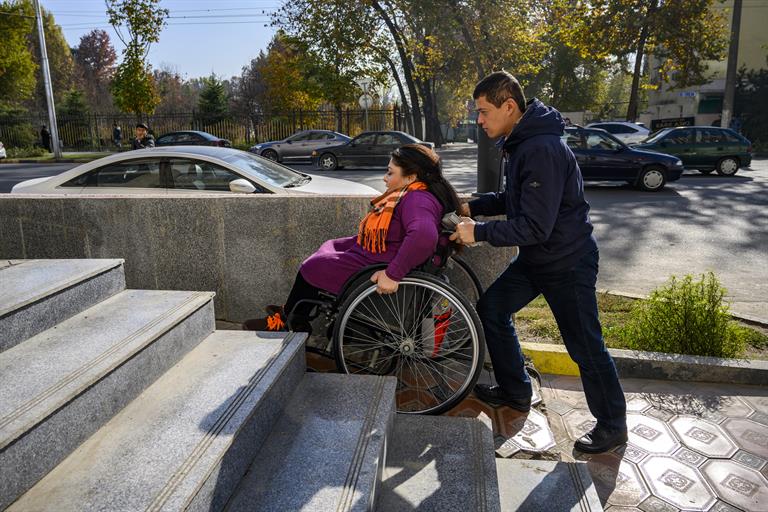For Sitora Kurbonova life in a wheelchair only spurred her on to build a better future.
After contracting polio as a child in her hometown of Kanibadam, in Tajikistan’s far-north, she lost the use of her legs as a child.
“My parents had to come up with a lot of new things for me. They reset their priorities,” she says.
A self-starter, she graduated with a Psychology degree from Moscow State University of Art and Culture, and now leads a public organization that fights for the rights of women with disability in Tajikistan.
“On my own initiative, I started working with people with disabilities back in 2004. I’ve helped with all sorts of support groups since then, for girls and women – both with and without disabilities.”
Like many countries, in Tajikistan, it’s often hard for people with disability to access crucial health services, as well as family, work and community activities.
“Last year I went for a blood test in [the capital] Dushanbe,” Kurbonova explains, “but I couldn’t get in because of the steps at the entrance. They wanted to take my blood on the street – as if that’s normal!”
“I was pretty upset about it, so I asked some passers-by to lift me up the steps. This way I could do the tests in a safe, clean environment, just like everybody else does.”

Sebastian Liste/NOOR
Barriers
A landmark WHO-Gallup study, funded by USAID, covering almost 1 billion people in India, Lao People’s Democratic Republic and Tajikistan, shows that there may be more people living with disability than previously thought.
The Brief Model Disability Survey and Gallup World Poll shows that in India, 16% of people over the age of 15 – around 145 million people – experience severe disability, along with 23% of Laotians and 8% of people in Tajikistan.
The study also shows that people with higher levels of disability face greater health problems.
Three out of four people with severe disability reported at least one health condition, with over 40% of people with severe disability reporting health problems that prevent them from doing things other people their own age can do.
In all countries – and likely worldwide – people with disability face major barriers to living healthy, active and fulfilling lives.
A lack of ramps, lifts, accessible housing and public transport makes life far harder for well over half of people living with disability in all three countries. They are also far more likely to live in poverty.
People with disability are more likely to need assistive devices, such as glasses, hearing aids or wheelchairs, and there is a huge unmet need – up to 30% in Laos for people with severe disability - for quality, affordable and user-friendly aids.
In Tajikistan – as elsewhere – stigma and discrimination also pose major barriers.
“One of our biggest problems is that we’re often just put away in the background,” says Sitora Kurbonova.
“These bad attitudes that mix compassion with being patronizing also bring down people’s confidence and self-esteem. We need to fight this, as it stops people with disability from taking part in society.”
According to the WHO-Gallup Survey, just 1 in 10 people with severe disability see themselves as ‘thriving,’ and in India and Laos, persons with severe disability are twice is likely to feel that their living standards are declining, with people in Tajikistan 4 times as likely to feel this way.
Action needed
“This data marks a clear call to governments in India, Laos, Tajikistan - and everywhere - to step up their efforts to build more equitable societies,” says Alarcos Cieza, WHO’s global coordinator for the programmes on sensory functions, disability and rehabilitation.
With population growth, ageing and a rise in non-communicable diseases like diabetes and heart disease, the number of people living with disability is rising worldwide.
“What we need is policies and actions that target people with severe disability and chronic conditions, and that boost access for people living with disability. This should include barrier-free health services, barrier-free public transport and accessible spaces to socialize.”
The WHO-Gallup study also calls on governments to boost access to food, shelter, job opportunities and communications technology and to enhance efforts to make communities safer.
Back in Tajikistan, Sitora Kurbonova is busy checking the accessibility and quality of the health services for women living with disability in her district.
“On the International Day of Persons with Disabilities – and every day - what we need is a whole of society push for a future where the human rights of all people living with disabilities are met in full,” she says.
“Disability inclusion is a fundamental human right. We just can’t wait any longer.”
